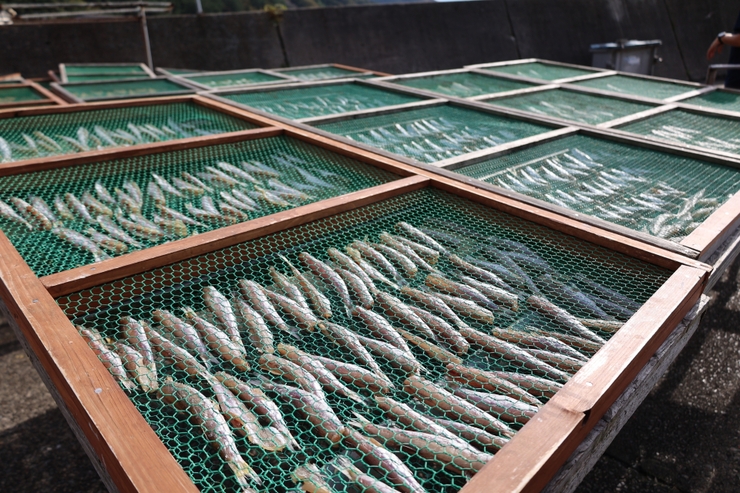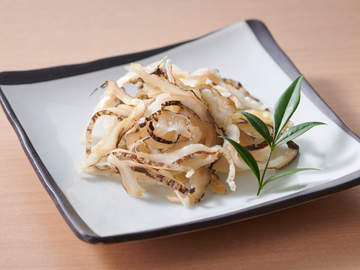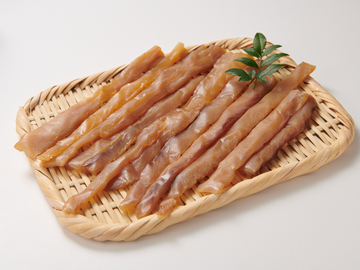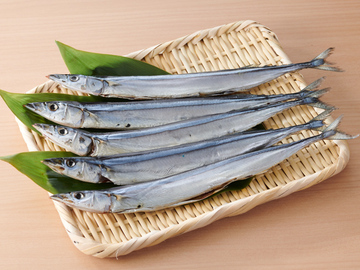Dried foods


History and Culture
Dried products are processed foods with enhanced shelf life. Dried products are produced by drying intact fish or fish from which the guts and gills are removed, and generally called himono or dried fish. Fishery products have high moisture content, and therefore are susceptible to deterioration and decomposition caused by autolytic enzyme and bacterial activities, which can be inhibited by reducing moisture through dehydration.
The history of dried fish dates back to old times. Evidence found at archaeological sites of the Jomon period suggests that people may have produced dried fish and shellfish. Himono is described as food used as shinsen (神饌) or offerings for gods in the Shoso-in documents from Nara period (710-784 A.D.). During the Heian period, himono was called "karamono," and himono was served at a banquet of noble people in the story of "the Tale of Genji." After the Edo period began, production of local specialties was encouraged by the feudal clans for the purpose of industrial development. Because of this and other factors, production of himono that represented the area started in many parts of Japan, and himono became an everyday dish for ordinary people.
Today, storage technologies such as freezing, refrigeration, and packaging are developed, and ichiya-boshi, soft overnight-dried fish with low salt and high moisture content, came to be produced by combining the traditional himono production method and modern food preservation technologies. Introduction of machines to the drying process allowed the manufacturer to dry fish independent of weather, which shortens the manufacturing process and prevents deterioration of raw materials during the drying process, indicating changes from traditional dried products.
Characteristics and Types
The drying methods can be roughly classified into two types: natural drying methods (tenpi-boshi), and drying methods using machine or desiccant. Some dried products are manufactured by a combination of one or more processes including processing after preparation, salt-curing, boiling, grilling, resulting in various drying types. These processes deactivate autolytic enzymes of the fish, preventing growth of bacteria adhering to the fish, and improving the shelf life; in addition, the processes also have an effect of facilitating drying.
When dried, some products may be imparted with flavors and textures that are completely different from those in the fresh state, such as dried herring fillets (migaki-nishin), dried cuttlefish, and dried sea cucumber.
Main types of dried products and specific fish products are presented below.
| Type | Characteristics |
|---|---|
| Dried | Raw materials are dried after washing with water. Some dried fishery products are consumed as is (e.g., dried cuttlefish, dried sardine sheet, dried nori seaweed), while others are used for cooking after soaking in water (e.g., dried herring fillets, dried codfish, and dried crushed wakame seaweed). (Dried Japanese anchovies, dried herring fillets, dried cuttlefish, dried shark fins, dried sea cucumber ovaries, and dried nori seaweed) |
| Salted-and-dried | Raw materials are cured in salt and then dried. During curing, the fishery product is aged, and develops unique flavors. (e.g., dried whole big-eye sardines, dried cut-open horse mackerels, codfish skin removed, dried young yellowtail, karasumi (salted-and-dried mullet roe)) |
| Seasoned-and-dried | Raw materials are seasoned/marinated and then dried. (dried mirin-marinated fish of different varieties, dried mirin-marinated sardines, dried stingray fins) |
| Boiled-and-dried | Raw materials are boiled and then dried. Niboshi (dried anchovies) are often used for dashi broth (soup stock). This is because the autolytic enzymes of the fish are deactivated by boiling, and the umami component is kept unchanged. (e.g., dried anchovies, semi-dried whitebait, dried shrimp, dried scallop adductor muscles, dried abalone, dried sea cucumber) |
| Grilled-and-dried | Raw materials are grilled over charcoal and then dried. Grilling helps remove fishy smell and imparts an aroma. (e.g., grilled flying fish, grilled-and-dried sardines, grilled sweetfish, grilled shrimp) |
| Smoked | Raw materials are marinated, smoked, and then dried (e.g., smoke salmon, smoked squid, smoked scallop adductor muscles) |
| Freeze-dried | Raw materials are dried after undergoing freezing and thawing (e.g., mentai (spicy cod roe) and agar) |

Production Methods
The simplest manufacturing method is sun-drying. Intact fish or fish from which the guts and gills removed, cut open and washed thoroughly is dried under the sun or by other means. While the method is simple, it is necessary to control freshness of raw materials, drying temperature, humidity, and duration, time, and other technical skills.
To produce salted-and-dried fish, either the entire pre-treated fish is salted, or immersed in brine with a salt concentration of 10%-20% (called "tatejio") before drying. The salt concentration of the brine and immersing time may vary depending on the type and size of fish.
To produce boiled-and-dried fish, pre-treated fish is boiled in brine (salt water) or freshwater, and then dried. Boiling deactivates autolytic enzymes as well as bacteria adhering onto the fish, and causes thermal denaturation of proteins, releasing water, which makes the drying process easier.
To produce grilled-and-dried fish, pre-treated fish is placed on a rack and grilled on a small charcoal grill called shichirin, or at the traditional Japanese hearth called irori, and then dried.

Relationship with Regions
Traditional himono using locally caught fish is handed down over generations in each region. Dried shishamo smelt that are consumed nationwide today is prepared by sun-drying the salted fish below 10°C, and originally, dried shishamo smelt was the preserved food of Ainu people in Hokkaido. Shiroebi, or white shrimp, well-known local specialty of Toyama Bay, is produced by drying, and is a popular ingredient used in dashi for somen noodles. Shiobiki salmon of Murakami City, Niigata Prefecture is produced by salt-curing a large-size whole salmon for a week, washing carefully, and having it exposed to cold wind from the Sea of Japan for about 3 weeks to age.

Kuchiko, the dried ovaries of sea cucumbers, is known as a local delicacy produced mainly in Anamizu-machi, Nanao City, Ishikawa Prefecture. Another well-known delicacy, karasumi, is produced by salt-curing mullet roe followed by drying. Karasumi was brought to Nagasaki, Japan during the Edo period, and is produced mainly in Nagasaki Prefecture today.
The majority of himono produced today are prepared by butterflying the fish along the belly. Traditionally, barracuda and halfbeak are prepared by a method called "Odawara-biraki," that is, butterflying the fish along the back with its head intact. Opening along the belly implies seppuku, and removing the fish head off reminds people of losing the battle. This shows a significant influence of the growing power of samurai society expanding from the area around Odawara in those days.
In addition, whale meat has long been an important food source for the Japanese. It is considered that whale meat had been already eaten in the Jomon period in Japan, which is evidenced by whale fossils or bones found in the Jomon remains. Though eating meat was officially prohibited after the arrival of the Buddhism, whale was considered as the same kind of fish at that time and thus whale meat was excluded from the prohibited list. So, the Japanese continued to eat whale meat as a valuable source of protein. Organized whaling began in the Edo period, which increased the supply of whale meat. Since then, whale meat became available to the common people and whale eating culture was flourished all over Japan. In the post-war years when the people suffered from food shortage, whale meat, which was a cheap and nutritious foodstuff, supported their life. Tatsuta-age (fried whale meat) was a regular dish served at school lunch. Processed whale meat products include whale sauce, which is made by soaking whale meat in sauce and drying it. It is a local food in Minamiboso region in Chiba Prefecture.
References
Takao Kurokawa, Kenichi Kawasaki, Ryoji Tanaka, Taku Wada, Hiroyasu Oka, Toshiro Mori, Kazutoyo Kanzaki, Muneaki Iwamoto, Akihide Takiguchi, Kazushige Usui, Takeshi Fujiwara, Masakatsu Yamazawa, Takeshi Shirakawa, Hiromi Kunitake, Satoshi Mochizuki, and Akira Nomura, edited by the Japanese Society of Traditional Food, "Nihon no Dento Shokuhin Jiten" [Encyclopedia of Traditional Japanese Food], Asakura Publishing Co., Ltd., p.286-351



